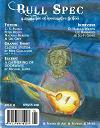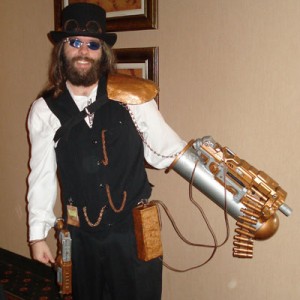written by Frank Dutkiewicz
 Bull Spec is the newest pro-paying magazine to hit the speculative fiction bookstore shelves. It is the brainchild of Durham, North Carolina’s favorite son, Samuel Montgomery-Blinn. Sam has an ambitious plan for his magazine; display the best North Carolina has to offer, showcase all that is new and relevant in the world of speculative fiction, and become the next SFWA qualifying magazine.
Bull Spec is the newest pro-paying magazine to hit the speculative fiction bookstore shelves. It is the brainchild of Durham, North Carolina’s favorite son, Samuel Montgomery-Blinn. Sam has an ambitious plan for his magazine; display the best North Carolina has to offer, showcase all that is new and relevant in the world of speculative fiction, and become the next SFWA qualifying magazine.
Sam was kind enough to send me his first copy to find out what I thought. At 72 pages, there wasn’t a shortage of things for me to comment on.
Rise Up by C S Fuqua
Life took a turn for the better the day Bobby walked into Sharps & Flats. Not only did he find a jewel of a music store but he also found Wynne, the love of his life and missing piece to his band. True, the old lady who owned the store was a bit odd, speaking nonsense on how music had power and was a conduit to the spirit world, but she did know her music. With Wynne’s help, Bobby’s band found new heights. A drive to meet a record executive brought it all to halt.
When he pulled Wynne’s lifeless body from the twisted car, Bobby thought his world just ended. The old lady said he had the power in him, a power over life and death. Bobby had no idea that the line between life and death wouldn’t be so clear.
C S Fuqua employed a tactic that I am finding more common these days. Open your story with the most dramatic part of your story then flashback to show the events that led up to it, risky and difficult to pull off. It almost didn’t work, almost.
Rise Up opened with a car crash (which was done well). After the dynamic opening, half of the story became a build up to the crash. The flashback, I thought, was slow developing and my interest waned. The story had a familiar tone to it and I believed I could see where it was heading from a mile away. Mr. Fuqua proved that I wasn’t a bright as I thought I was.
Good horror (which is what I believe this is) isn’t about gore but about the unexpected, and I admit I didn’t expect where Rise Up ended up. C S Fuqua is a master of prose. I found his writing crisp, filled with details that make a story come to life. But for my tastes, Rise Up wasn’t all that grand. The characters weren’t all that interesting and their story wasn’t that deep. For a large section I found the story dull and wondered if the payoff for sticking with it would be worth it. I am happy to say it was.
Rise Up is a solid but thin story. The writing is worthy of a professional publication. Not too bad for an opening to the magazines first publication.
Almost A Good Day To Go Outside by Peter Wood
Ricardo has brought home the latest fad for his family to enjoy, a TV. Just in time to catch the 1950’s programming that is just now reaching the terraforming colonist. The TV is a distraction for Ricardo’s cabin-fevered family. The entire population of the colony is confined into a single mammoth structure called the hive. The terraforming is taking longer than anticipated and depression is setting in. Daily routine with no place to go is having an adverse effect, one that is tearing Ricardo’s family apart.
Imagine working in a large factory, raising your family inside its walls, and never being able to leave. Peter Wood effectively showed a small slice of such a problem. In Almost A Good Day To Go Outside we also see the flipside of the problem. On a planet light-years from Earth, workers can’t be replaced, no matter how badly they do their jobs.
Almost A Good Day To Go Outside is a good Sci-Fi story. I liked the dilemma presented and the solution at the end. It was an idea I’d imagine the great writers of the 70’s would think of, yet would be still relevant today. Although I thought the story lacked a depth of detail and settings that C S Fuqua so eloquently provided, it had a quick pace with characters I could relate to.
I enjoyed reading this one.
Doctor Adderson’s Lens by Natania Barron
(reprinted from Gatehouse Gazette)
It was not unusual for Dellacarta to be summoned by her employer, Dr Adderson, even if it was by her reanimated zombie brother, Anton. She is used to the unusual and strange as an aide to the brilliant doctor, or she thought she was. One look through his latest invention, a monocle that grants sight of an unseen realm, and she realized that there is more to fear than an undead brother.
I classify this one as something that came out of left field. Steampunk stories can be strange but Doctor Adderson’s Lens has to be one of the oddest stories that I have ever read. Ms Barron effectively made reanimated corpses as servants seem normal. The unseen bird/parasites were an abrupt turn in an odd piece. The style of writing a story as a past tense recollection I found distracting.
Doctor Adderson’s Lens is not my type of story but I can see how many would love it. I found the plot a bit compressed but it did amuse me.
A Gathering of Doorways by Michael Jasper
(novel excerpt)
We get a glimpse of Mr. Jasper’s prologue and first chapter in his latest novel. The prologue is a recollection of dream Gil has of a place called the ‘Undercity’. We learn of his wife plus one family, and a real life problem with polluted water on their farm. Much of the prologue is devoted to his dream of the Undercity, which looks like any old, normal city, but for reasons unknown, the dream keeps him awake most nights.
In the first chapter, Gil is looking for his recently missing son, Noah. He is joined in the search by his neighbor Ray and his dog. Both men are disabled and there is an underlying fear of the forest that young Noah has wandered into.
I found the prologue to be unclear. It didn’t build a curiosity about Gil, his problem, or about the mysterious ‘Undercity’. The first chapter was more relevant but the flashback, which couldn’t have been more than a few minutes before the opening dilemma, and the unexplained mysteries of the forest, polluted water, and Undercity, left me more lost than intrigued. Gil’s bad hip, judgmental wife, and dark reference to a shovel and a squatter, wasn’t enough for me to want to know more.
When shopping for a novel, I like to read a sample of the book, especially when the author is new to me. The sample Bull Spec provided should be a perfect length to draw a conclusion. May I suggested to future authors, that take advantage of the mutually beneficial service, that you need not present the beginning of the novel, just an early portion. I suspect a better scene to hook potential readers could be found in a later chapter for A Gathering of Doorways.
The excerpt should be enough for readers to get a feel for Mr. Jaspers writing. Not for me, but judging by the reviews that he had for the entire novel, I’m sure more than a few readers will want a closer look.
Closed System Part One: The Author of Time by Mike Gallagher
(comic strip)
The hero of Mr. Gallagher’s work is Cambridge University’s chosen time traveler. He is traveling back in his flying ape-headed time machine to ‘document false historical facts’ as one of his tasks, which he finds many of, as well as few faux pas the got by the author (potatoes in the middle ages, George Washington at the signing of the Declaration of Independence).
The art of the strip is done well, and the story he created is fitting for a comic strip. I am sure a few readers would be interested in the ongoing adventures of the traveler.
D Harlan Wilson an interview and review of his works.
Huh?
It was the first word a writer used in his review of Wilson’s novel Peckinpah, and a word that summed up my thoughts of the first half of Bull Spec’s interview with Mr. Wilson.
In Sam Montgomery-Blinn’s in depth interview, we learn that his latest novel has been long-listed for a Bram Stroker award, that he has sold many other works of fiction, is regarded as a respected literary critic and analyst, has a masters in SF studies (who knew that existed), and has a PH.D devoted to a genre that he admits ‘â€academia still consider(s) (SF literature and scholarships) as trash, detritus of the literary ghetto‒
Quite an impressive resume, which proves the point that just because I never heard of him, doesn’t mean he isn’t important.
In Mr. Blinn’s lengthy review of D Harlan’s Technologized Desire: Selfhood and the Body in Postcapitalist Science Fiction we get a glimpse of his critiquing talents as well as his opinions on the direction of Science Fiction as well as how it relates to the attitudes of today’s society. Mr. Blinn’s sums up D Harlan’s theme with his quote “the universe of consumer-capitalism is an illusory prison from which there is no escape,despite the fact that it is illusory” and delves deeper into his description of Sci-Fi’s tendencies toward “technocapitalist” futures, a dark and dreary existence for man, one where “free will is fiction”.
In J. David Osbourne’s review of Mr. Wilson’s Peckinpah: An Ultraviolent Romance, we get a view of D Harlan’s fictional prowess. By Mr. Osbourne’s brief analysis, the novel sounds every bit as bloody as the title suggests. J. David summarizes it to be a “â€satirical meta mash up of microfiction and microcriticism into something that maybe resembles a novel,
Both reviewers thought highly of the novels, as did the editors of D Harlan Wilson in the interview. They know him better than I, but unfortunately (like most first time readers to Bull Spec) I base all my impressions on what I have read in these few pages.
Mr. Wilson comes off as a bright but bitter man. He sounds as ostentatious as his lengthy book titles, and as sure of his opinions as the blunt messages in them (the titles). Of course, good critics aren’t afraid to share their opinions, and D Harlan is all too happy to share what he thinks.
He used his boyhood town of Celina, OH as a template for his fictional novel, a place he admitted he “hated’. He sums up his time at Michigan State University as a “sh*t experience” while earning his PH.D, describing the program as “â€full of glitches ranging from structural disorderliness to crummy and/or meatheaded faculty.” The critic Mr. Wilson also commented on his contemporary, Stephen King. Admitting that he respected him — not for his writing, but for the fact he got rich writing it.
D Harlan’s dour outlook on society and mankind’s fate really comes through on his criticisms of Science Fiction over the past few decades, especially in the art of film. He focuses on the darkest of works, choosing to stick with the Blade Runner blueprint of a dire future, one’s that examine the depressing eventualities where technology and human physiology merge in a parasitic relationship (and it’s unsure which is the parasite). He concludes the evolution of SF and mankind’s fate is likely to head toward a future of “no choice but to live as a technopathological extension of the machine.” Mr. Wilson comes to these conclusions by saying capitalistic technologies shape SF ‘for “unrelenting socioeconomic ends” in an increasingly violent, self-perpetuating cycle of production and consumption.’
While reading Sam’s interview and the two reviews of D Harlan’s fictional work and analytical critique, I couldn’t help to think ‘this guy is overeducated and probably hasn’t held a real job in his life’. Noticing how he used the word ‘capitalism’ as if it were a curse word only solidified my first impression. Mr. Wilson’s bases his conclusions on an assumption of capitalistic societies are evil and counter productive to mankind, as an accepted universal truth.
Mr. Wilson furthers his conclusions of Science Fiction reflecting the cynical nature of man eventual demise through a symbiotic relationship with technology, fueled by a capitalistic engine, by examining the darkest of SF works such as A Clockwork Orange, Fire on the Mountain, and Army of Darkness. While looking on how a world would come about in the Matrix trilogy.
His works of fiction also reflect his cynical attitudes. He is proud of his works but finds them difficult to classify, describing his style as “creative freedom in narrative catastrophe,albeit catastrophe with order and purpose.” His latest accomplishments are of trilogy he calls “Scikungfi” (good grief), a story of a time jumping man that knows kung fu. His Peckinpah novel is filled with what the reviewer described as “hyperviolence”. His novels follow the same path as the ones he gravitates to in his critical analysis, reflecting the worst of human nature. All of which makes for some very depressing reading, which brings me to my own theory on how a bright mind could have such a bleak outlook and reflect it in his writings and criticisms.
D Harlan Wilson admitted he didn’t discover Science Fiction until his early twenties, when he was already hip deep in academic studies at a high-pressured Masters program. That time of life is usually the most cynical in a person’s life. The world seems to be against you and people in power appear to be interested in their own ends instead of working toward the good of the people. Most Sci-Fi and fantasy genre fans first discover the genre at an earlier age, mid to early teens. It is a time when the world looks bright; full of hope and opportunity. Most readers look for the type of entertainment that fits their ideal outlook. What you first fall in love with is what tends to stick with you.
It is the reason why the Star Trek phenomenon has such legs (a fictional work Mr. Wilson ignored). It is an idealistic future, one that shows a promising future without limits. Most works of SF I read followed this theme. Granted, I don’t read as much SF novels as I used to, but most of the mountain of short stories I’ve sample over the past couple of years has stayed true to this future of hope.
D Harlan Wilson may be correct of the future of SF and mankind but I tend to doubt it. Humans are not inheritably evil beings that are after their own narrow interests, nor are they sheep that will accept techno-attachments so willingly, as a decree from the powers that be. Capitalism is not an engine that is out to control and subvert man. Corporations need customers. Zombies make lousy consumers.
Any person that becomes a parent realizes that a future is important. As long as children grace our lives, I choose to see man’s future as a promising one, and most SF will continue to reflect that promise.
I wonder if D Harlan Wilson would buy my notion of a bright future? He better. Resistance is futile.
The Other Stuffâ€
The Windup Girl by Paolo Bacigalupi (as reviewed by Blue Tyson) is a novel set in a future where most of Earth’s oil reserves have been exhausted. Set around Bangkok, much of the power generated is done so by the kinetic energy from human labor and genetically engineered animals. The novel is done from more than one perspective and brings to life a world that must deal with mutated animals and diseases brought upon by meddling with genetics. New political lines, old technologies, and fresh technological solutions for a power-starved world appear to be the draw of this novel.
Tyson’s review describes Bacigalupi’s novel as a dystopia, one that “leaves you uneasy the whole way through, but fascinated”. Mr. Tyson is so enamored with it that he gave it 5 stars, and believes that it will be important to the future of Sci-Fi. I can’t imagine a higher praise than that.
Panverse One edited by Dario Cireillo (as reviewed by Charles Tan) is an anthology with five original novellas. The theme is unclear but Mr. Tan does provide a small review for each story. I found the cover of the book fascinating and Charles leads me to believe the work within is fitting for it. He writes favorably of each story but reserves his highest praise for “Delusion’s Song” written by Alan Smale, proclaiming that it is deserving of an award.
Although short, Charles Tan’s review was the most convincing as a sales pitch. I just may buy myself a copy.
There are two poems in Bull Spec. Inspired by Windmills by Kaolin Imago Fire and Ratang by Ralan Conley.
As one not drawn to poetry I have little to offer. If I were to pick from the two I would choose Ratang for its humor.
In Sam Montgomery-Blinn’s interview of game developer, Lee Hammock, we learn of the creation and premise of one of the most anticipated RPG games of the year, Fallen Earth.
The premise of the game is set in the year 2156 in the Grand Canyon. It is a hundred years after a plague has wiped out 99.9% of life on Earth. The Shiva virus has mutant life. Players in the game are immune carriers that battle deadly monsters while escaping from a revolt of dictatorship that controls the Hoover Dam.
Mr. Hammock provides insight to what potential players may face in the game as well as the direction the designers are planning for future adaptations to the game as well as the collaborative process involved in creating the game.
The conversation between Sam and Lee changes to Lee’s earlier RPG games and to his contributions to the graphic novels of the Halo RPG. Mr. Hammock speaks highly of his writing team as well as rubbing elbows with his colleagues, even showing a little envy for a successful competitorâ€
“â€you’re going for a burrito, why are you driving the Lamborghini? That’s just rubbing our noses in it!”
If only I could face such problems.
I am not one to play computer RPG games. However, it would be naÃ�’ �ve to ignore their effect on today’s SF market. The shelves of the bookstores are filling with these fan-fic popular books. Lee Hammock, I imagine, is a person that fascinates many people. This interview should provide a glimpse many are after.
Sam also interviews the owner (Jennifer Bedell) and manager (Zachary Boyd) of SCI-FI GENRE COMICS AND GAMES. The store, located at 3125 Old Chapel Hill RD, Durham, NC, is set in an old warehouse. It is a haven for those that love the games, D&D games, and collectable game cards, like the Magic Gathering that have become popular.
The store boasts a sizeable staff that can provide you help that no ordinary department store can. The duo have a business plan that I hope keeps it alive for years to come. It sounds like a fun place to visit.
There is also one micro-flash story titled There Are No Orcs by Josh Whiton, short but sweet. It is translated into French and Spanish. Wouldn’t it be something if it were to become the Rosetta Stone for future generations?
If you are looking for variety in your Speculative Fiction, Bull Spec is the magazine for you. The stories cover a wide spectrum for fans of all types. The reviews and interviews follow the same pattern. I believe that is wise if the editors are looking for a wide audience. I did see one thing that linked them all together. All the stories, as well as the subject in the chief interview, were a shade on the darker side. Could be it was just a coincidence but I worry it could become common because of the prevailing tastes. Knowing that all the works of fiction carry that same theme would make them predictable over time.
Other than the slightly shaded theme, all the storytellers varied in quality and style. The differences were good and added to my enjoyment. However, the most thought provoking item in the magazine was D Harlan Wilson’s interview.
Of the three short stories I thought Rise Up was written the best but A Good Day To Go Outside I enjoyed the most. All the reviews I found helpful and I encourage Bull Spec to continue this service. I also appreciated the novel excerpt. Keep that up as well.
Sam Montgomery-Blinn’s interviews were well done. He asked relevant questions and steered the conversations on an engaging path, getting his subjects to relax, which made for a lot of information given freely. Quite a skill he has for this. Perhaps that microphone Sam is talking into on page 63 explains how he fine-tuned that skill.
I thought the artwork was well done, the announcements at the end informative, and the GUD ad fitting. The quality and set up of Bull Spec is worthy of any pro-magazine. However, for Bull Spec to become a SFWA it needs to stand out.
The cover art by Mike Gallagher is drawn well, a little too well. If Bull Spec is sitting on a long rack in a bookstore among a hundred of other magazines, I may assume it to be an American Art Review knock off. Although the old woman presenting a mandolin did fit the lead story it wouldn’t have been enough to capture my eye.
Bull Spec is full of variety but it isn’t set up that way. The first third is all stories, then all reviews and interviews from that point on. It is wise to place your lead story in the opening pages but the interviews, I thought, should have been mixed in with the fictional works. The readers that aren’t so inclined to read interviews may toss the magazine aside and remember Bull Spec to be thin in content because only the first 20 to 30 pages interested them.
Bull Spec did make for a nice read. Enjoyed all the stories, liked that they were spread across a variety of genres, appreciated the reviews, and was impressed by the interviews. What I would like to see from future issues would be more of a mixed format. Also there were four stories to enjoy but only two were original shorts and one of the four a novel excerpt. The interviews were nice but three was one too many. Lee Hammock and D Harlan Wilson were both worthy of headlining promotion, splitting them up onto separate issues might have been a better idea. One more original work of fiction and one less interview I think is the way to go, and it is that additional work of fiction I believe would put Bull Spec on the map.
The only thing the magazine needs to make it stand out is star power, a recognizable name on its cover. Without knowing the inner workings of running or editing a magazine (which may make me naÃ�’ �ve), the editors should reach out and offer a spot in its pages, even if it is sight unseen, to a big name in SF. It would be the magnet Bull Spec needs. True, C S Fuqua and Michael Jasper are not first time writers, but there are several well known attention grabbers that may be all to happy to showcase there work for a new audience. All it might take is contacting them or their agents. In fact, D Harlan Wilson may have been able to provide one of his short works for the magazine. I learned of who he was in the interview, what the reviewers thought of his two books, but aside from a brief excerpt in one of the reviews, I have no idea of what his writing was like.
All in all, I thought Sam and his staff did a fine job with their debut issue.
Look for Bull Spec to be gracing the shelves of your favorite bookstore, or you can order a print copy or PDF copy online. The PDF copy is available for “donate what you want”, and yes that includes $0 (but if you like it I hope you consider chipping in a few bucks). I recommend that you get yourself a copy.
 Frank is a truck driver that pretends that he can write. He’s managed to fool a few publishers, with the latest being Strange, Weird, and Wonderful, where his story Playgel Riser will debut this summer. Frank has been driving for over twenty years without an accident or traffic ticket on his record. HeÂis able to boast this claim because ofÂhis professional attitude, skilled driving, and a really good lawyer.
Frank is a truck driver that pretends that he can write. He’s managed to fool a few publishers, with the latest being Strange, Weird, and Wonderful, where his story Playgel Riser will debut this summer. Frank has been driving for over twenty years without an accident or traffic ticket on his record. HeÂis able to boast this claim because ofÂhis professional attitude, skilled driving, and a really good lawyer.
 So, Heather and I went to a She & Him concert at First Avenue for our 6th wedding anniversary.
So, Heather and I went to a She & Him concert at First Avenue for our 6th wedding anniversary.






